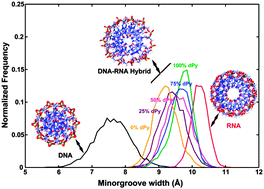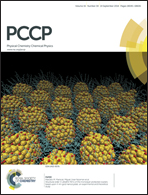DNA–RNA hybrid duplexes with decreasing pyrimidine content in the DNA strand provide structural snapshots for the A- to B-form conformational transition of nucleic acids†
Abstract
DNA–RNA hybrids are heterogeneous nucleic acid duplexes consisting of a DNA strand and a RNA strand, and are formed as key intermediates in many important biological processes. They serve as substrates for the RNase H enzymatic activity, which has been exploited for several biomedical technologies such as antiviral and antisense therapies. To understand the relation of structural properties with the base composition in DNA–RNA hybrids, molecular dynamics (MD) simulations were performed on selected model systems by systematically varying the deoxypyrimidine (dPy) content from 0 to 100% in the DNA strand. The results suggest that the hybrid duplex properties are highly dependent on their deoxypyrimidine content of the DNA strand. However, such variations are not seen in their corresponding pure DNA and RNA duplex counterparts. It is also noticed that the systematic variation in deoxypyrimidine content of hybrids leads to gradual transformation between B- and A-form nucleic acid structures. Binding free energy calculations explain the previous experimental findings that the hybrids with high deoxypyrimidine content (>50%) are more stable than their respective pure counterparts. Pseudorotation angles, minor groove widths, phosphodiester angles, and glycosidic dihedral angles exhibit gradual A- to A/B-like conformation with decreasing deoxypyrimidine content. Based on extensive analysis, possible factors that affect RNase H enzymatic activity on hybrid duplexes with high dPy composition are proposed.


 Please wait while we load your content...
Please wait while we load your content...